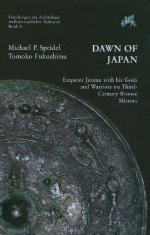|
This section contains 323 words (approx. 2 pages at 300 words per page) |
JIMMU, the first emperor of Japan, direct descendant of Amaterasu, the supreme deity, and generally regarded as the ancestor of the present Japanese emperor. Amaterasu's offspring, Ame no Oshiho-mimi, begot Ho no Ninigi, who descended from Heaven to earth. His offspring, Hiko-hohodemi, begot Ugaya-fukiaezu, whose offspring was Jimmu.
Jimmu is a Chinese-style name given to this emperor much later; his original name was Kamu-yamato-iwarehiko. Kamu means "divine," and Yamato is the name of the location of the ancient capital. The semantically significant portion of this name is iwarehiko. Iwa means "rock," and are means "to emerge." Since hiko means "a respectable person," Jimmu's original name, Iwarehiko, suggests "a respectable person who emerged (or was born) from a rock."
According to the early chronicles, Jimmu was born in the province of Himuka on the island of Kyushu in western Japan. He led a successful expedition to conquer the east and ascended the throne in Yamato in 660 BCE. Historians, however, reject this date because at that time the Japanese still lived in scattered tribal communities. It was only in the second century CE that a unified political organization emerged in western Japan. Although the date of 660 BCE is not acceptable, the description of the Jimmu expedition to Yamato is vivid and realistic. It is unlikely that the story itself was fabricated in later days to glorify the imperial ancestor. It is assumed that the army led by Jimmu entered Yamato in the early second century CE and that Jimmu played a major role in establishing the Yamato state.
See Also
Amaterasu ŌMikami; Japanese Religions, Article on the Study of Myths.
Bibliography
Aston, W. G., trans. Nihongi: Chronicles of Japan from the Earliest Times to A.D. 697 (1896). Reprint, 2 vols. in 1, Tokyo, 1972.
Chamberlain, Basil Hall, trans. Kojiki: Records of Ancient Matters (1882). 2d ed. With annotations by W. G. Aston. Tokyo, 1932; reprint, Rutland, Vt., and Tokyo, 1982.
Kakubayashi, Fumio. Nihonshoki Kamiyo-no-maki zenchushaku. Tokyo, 1999.
Philippi, Donald L., trans. Kojiki. Princeton, 1969.
|
This section contains 323 words (approx. 2 pages at 300 words per page) |


